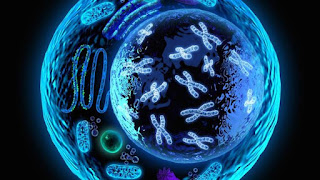 BIOCHEMISTRY OF CELL:-
BIOCHEMISTRY OF CELL:-
As we all know our body is made up of trillions of cell in which all chemical reactions take place.Cell is the basic structural and functional unit of our body.Cell is divided ino two parts:-
1-Nucleus
2-Cytoplasm
NUCLEUS:-
- Nucleus means core of body or any object.
- Nucleus is known as the brain of cell because all the hereditary activities takes place in it and it also takes part in protein synthesis.
- It is separated from cell by a thin nuclear membrane.
- It consist of fluid like mass called nucloplasm.
CHROMATIN:-
- Chromosome consist of a substance called chromatin.
- chromatin further condense to form chromosomes
- It consist of both DNA and RNA which are formed in nucleus.
- It is a combination of DNA and proteins.
- Occurs in two forms euchromatin and heterochromatin
- heterochromatin is about 90% in chromatin being inactive
- it plays an important role in wrapping of histones in chromosomal formation.

NUCLEAR MEMBRANE:-
- Known as nuclear envelope
- It encloses nucleus in it and separates it from the cytoplam
- It is made up of intermediate filaments give strength to membrane
- It is strong due to its criss cross arrangment of nuclear protoplasm which also plays role in attachment of chromosomes.
- It consist of small nuclear pores which is made up of about 50 proteins assembled together.
- Due to bilayered structure it easily commounicates with rough endoplasmic recticulum which is helpfull in protein synthesis.
NUCLEOLUS:-
- Refractile body in nucleus
- Consist of proteins and nucleic acid
- Site of transcription of proteins with accompany of rough endoplasmic recticulum
- The network of strands can easily be seen in nucleolus
- It also takes part in ribosomal assembling
- rRNA are encoded here.
CYTOPLASM:-
follwing are the organelles
- Mitochondria
- Lysosomes
- Endplasmic recticulum (rough & smooth)
- Ribosomes
- Peroxisomes
- Golgi complex
- Endosomes
- Centrioles
- cytoskeleton
MITOCHONDRIA:-
- Power house of cell.
- It is concerned with oxidative phosphorylation which results in production of ATP .
LYSOSOMES:-
- Minute bodies seen in cytosol bounded by membrane
- It produces lysosomal enzymes which are acid hydrolases
- Enzymes are heavily glycosilatd and maintained at low ph
- enzymes are first formed in RER where carbohydrates is also added then passed in to golgi complex for further packaging.
- enzymes undergo a change of their mannose to become able for targetting particles
- it performs activities in two ways
- Autophagy ( hydrolytic digestion of worn out cells)
- heterophagy(hydrolytic digestion of exogenous material)
- It also plays an important role in protein degradation
ENDOPLASMIC RETICULUM:-
- Ultra microscopic organelles
- A continuous system of interconnecting embrace bounded channels that is present through out cytoplasm
- divided into granular and agranular
- Rough (granular)
- Smooth (agranular)
- Ribosomes are attached on the outer surface
- Protein factories
- It has a special protein known as CHAPERONES which work as protein assembler.
- some carbohydrates are also synthesized in cavities along golgi complex attaches to protein the process is called PROTEIN GLYCOSYLATION.
- Takes part in lipids cholestrol other steroids synthesis like adrenal cortex hormones
- Ca+ ions are transported to sarcoplasm recticulum for skeletal muscle conraction
- Plays important role in following chemical reactions:-
- phospholipids synthesis
- desaturation of fatty acids
- enlongation of faty acids
- omega oxidation in fatty acid
- sterol synthesis
RIBOSOMES:-
- Site of protein synthesis
- It has two sub units which differ in size it contain 4 different rRNA chains and about 73 different proteins.
PEROXISOMES:-
- Microbodies lined by single membrane.
- about 50 enzymes are demostrated in it
- peroxisomes are proteins which are synthesized oncytosolic polyribosomesandfold into prior.
- involved in metabolism of many molecules including fats and other lipids
- it takes part in oxidation of fatty acids
- participates in synthesize of plasmologen,cholestrol and dolichol.
GOLGI COMPLEX:-
- Situated near nucleus
- Consist of flattened cristerns
- When the protein enters in golgi it screens it these proteins.
- Site of formation of carbohydrate side chains of glycoproteins and mocopolysaccharides
- Site of production of primary lysosomes
- Give rise to acrobat of spermatids that is converted into acrosomes of spermatozoa.
- In females it is believed to facilitate fertilization
ENDOSOMES:-
- the word means vesicles that has lost coat
- Four clases
- early endosomes
- recycling endosomes
- multivescular bodies
- late endosomes
CYTOSKELETON:-
- Large number of proteins formed by microfilaments,intermediate filaments and microtubules which forms complex network
- following functions are performed by it
- internal reinforcement
- anchors microvilli and cilia
- mediates in cell to cell and cell to extracellular matrix adhesion
- responsible for cell motility
- involved in assembly of new filaments eg: centrioles


Good work Rabeea
ReplyDelete